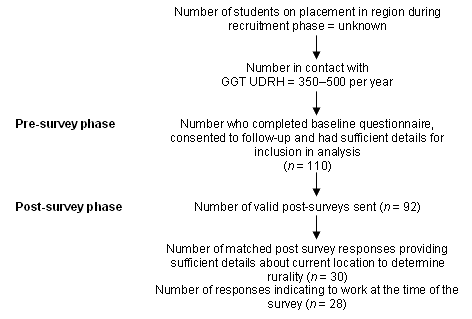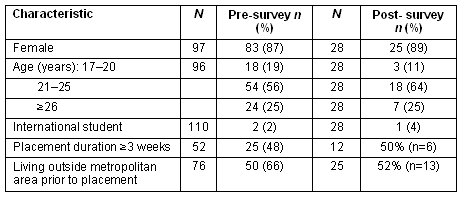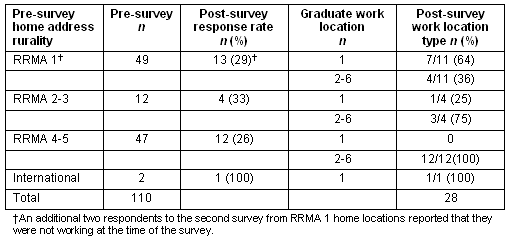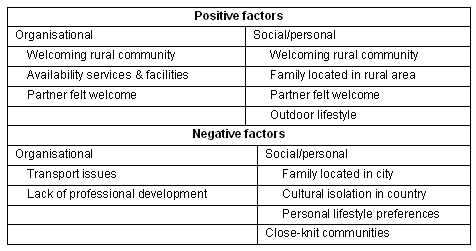full article:
Background
One of the key activities of University Departments of Rural Health (UDRHs) is working with health professionals and their agencies to facilitate clinical placements for students in rural Australia as a means of building the health workforce capacity1. The hypothesis is that exposure through clinical placements to the professional and personal opportunities in rural and remote areas will encourage more graduates to seek employment outside metropolitan areas. So far, limited evidence supports this hypothesis. For example, a survey of nursing students pre- and post-rural clinical placement found a 12% increase in the number of students intending to seek rural employment2. More than 30% of the nursing students who undertook undergraduate rural placement had no previous experience of a rural lifestyle and, after their rural clinical placement, more than 50% of this subgroup indicated their intention to seek rural employment2.
Much of the research has focused on discipline-specific student placement, particularly in medicine3,4 and nursing2. There is a dearth of research that focused on allied health professions, and possible differences among students from different disciplines. This article reports on a pilot project that aimed to provide some insight into students' motivations to take up a rural health position after graduation, and also to produce information about optimising the quality and quantity of rural clinical placements. In total, 30 students were tracked who completed a clinical placement in the Greater Green Triangle (GGT) region in the south east of South Australia and the south west of Victoria during the period 2004-2006. The objectives were to:
- Examine the relationship between rural student placements and the take up of rural medical, allied health and nursing positions.
- Explore the factors that influence early graduates' opinions regarding whether or not they are interested by a rural career.
Method
Participants
Approximately 350-500 medical, allied health and nursing students complete clinical placements in the GGT region each year. Approximately 35% are medical and dental students, 25% nursing students and 40% allied health students. These student ratios can fluctuate year by year according to factors such as the availability of clinical supervisors.
The questionnaires
Two questionnaires were made available for participants. Participants completed the first questionnaire ('pre-survey') of 23 questions at the end of their undergraduate placement in the region. The questions related to the quality of the student placement and factors that impacted on the student while on placement, for example the physical and social environment. The second questionnaire ('post-survey') consisted of 12 questions and was sent to participants after they had graduated, asking about current working status, work location and the factors that influenced their choice of work location (eg rural upbringing), and future career goals. Questions on the post-survey also related to issues of recruitment and possible retention of the new graduate that had influenced the career choice after graduation. Appendix I shows question examples from each of the questionnaires.
The questionnaires were not coded but participants were able to insert their contact details so that the pre-survey and post-survey could be matched.
Procedure
The study received approval from the Flinders University Social and Behavioural Research Ethics Committee.
When students undertake a placement in the south west of Victoria or the south east of South Australia, they are encouraged by their universities and the local health services to contact the UDRH for support while on placement. Students are able to avail themselves of academic support and book accommodation through the UDRH for their placement. Students are also offered a small bursary ($50) to help offset personal expenses, if they register their placement. When students contacted the UDRH for these services they were invited to participate in population health seminars, cultural awareness training and the program evaluation. Medical, allied health and nursing students on placement in the GGT region between 1 July 2004 and 31 December 2006 who contacted the UDRH were invited by email at the end of their placement to fill in a questionnaire about their placement experience. When the questionnaire was completed it could be returned to the UDRH by email, fax or mail. The first questionnaire included a section for follow-up contact details.
Students were informed that a second questionnaire would follow after graduation and would be sent to the contact details provided by the student. It was expected that most respondents would have completed their studies by late 2007. The post-survey was made available after graduation and up to December 2007.
Statistical analysis
Descriptive statistics were used and data were analysed using Microsoft Excel and SPSS (SPSS Inc; Chicago, IL, USA).
Results
One hundred and forty-one students completed the consent form for follow up of the initial survey. One hundred and ten of these provided sufficient details to be included in the analysis (their undergraduate course and rurality of their home location). Forty-nine of the 141 students who filled in the first survey could not be tracked (Fig1). This left a total of 92 responses that had an email or postal address, or a valid phone number and allowed contact with the participant for follow up. The follow-up survey was made available for online completion and by post for those who provided no email address. Of the 92 students who had indicated a follow-up contact, 33 of them had inactive email addresses. Four of these 33 did not provide a valid postal address and could not be contacted. This resulted in 88 students who were able to be contacted. Thirty-four of the 88 students (39%) who could be contacted completed the follow-up survey. However, four nurses did not provide postcodes in either the initial or in the follow-up survey and had to be eliminated from the analysis. This gave a response rate of more than 34% (n = 30, 24 females and 6 males). One of the 30 had not commenced work at the time of the survey and one was between jobs and could not be included in some of the analyses.

Figure 1: Recruitment and response process
Baseline characteristics
The characteristics described in Table 1 suggest that respondents to the post-survey were quite representative of those who undertook the pre-survey. Participants were mostly female, the majority were aged 21-25 years, they were largely domestic Australian students, and approximately half had previously lived outside a metropolitan area.
In the pre-survey, nursing, medical/dental and allied health/others accounted for 29%, 29% and 42% respectively. In the post-survey, the corresponding figures were 37%, 23% and 40%, indicating reasonably consistent response patterns among disciplines. The Rural, Remote and Metropolitan Areas5 (RRMA; http://www.aihw.gov.au/ruralhealth/index.cfm) classification was used to categorise respondents' home address location (pre-survey) and work location (post-survey). Based on home address in the pre-survey, 44% were from capital cities (score = 1), while 11% had RRMA scores of 2-3, and 43% had scores of 4 or 5 (2% were international students). In the post-survey, the corresponding figures for RRMA categories for location of current employment were 30%, 13%, and 47% (with 3% from RRMA category 6, and 7% not currently working). Ninety-six respondents provided pre-survey age data. In total, 19% were aged 17-20 years, 63% were 21-30 years, and 14% were over 30 years. The corresponding post-survey figures were 3%, 83% and 13%.
Response rates were relatively consistent for students from different RRMA categories (Table 2). Based on the data at post-survey, Table 3 shows that the large majority of participants who lived outside RRMA 1 areas as a student and a third of participants who lived within RRMA 1 areas when a student, finally worked in a regional location. Table 4 shows that the proportion of pre- and post-responses from different disciplines remained relatively consistent, with approximately one-third from nursing, one-quarter from medicine and dentistry, and approximately 40% from allied health, pharmacy and others.
Table 1: Pre-survey and post-survey respondents characteristics

Table 2. Graduate work locations, stratified by RRMA category of undergraduate home address

Table 3. Graduate work locations, stratified by health discipline categories

Most nursing participants and a majority of allied health participants worked outside RRMA category 1 locations. Conversely, this was so for under half (43%) the medical and dental respondents. Two were between jobs at the time of survey, one having already worked in a rural/remote setting since graduation.
Immediately following their placement, more than 50% of the 110 respondents reported that they felt that their placement in the GGT region had made them more inclined to commence rural practice. Forty-three percent stated that the rural placement had not influenced their opinion because they had always considered rural practice. Some students (approximately 7%) indicated that the rural placement made them less inclined to consider rural practice. Those who felt less inclined to take up a rural position were medical students. There was one allied health graduate who had not commenced practice at the time of the follow-up survey, and one who had finished a rural position and was between jobs.
Comparisons of rural perspectives by profession
There follows a comparison of rural perspectives by profession: medicine and dentistry, allied health and nursing.
Medicine (n = 6) and dentistry (n = 1): All seven respondents from medicine or dentistry had a metropolitan background (one from overseas). After graduation, three commenced in rural practice and four commenced in city-based practice. Two of the three who commenced rural practice had received a rural health scholarship. Placement ranged from one week to 45 weeks.
Those who indicated in the post-survey that they had commenced practice in the city cited predominantly family, transport, cultural and professional development reasons for remaining in the metropolitan area for work (n = 4). Statements in the pre-survey from this group of four included:
I prefer the city life. Better transport system (I don't drive) and more cultural diversity. Better clinical teaching.
Will not work in rural area as it aggravates my reactive airway disease and makes me short of breath.
In the follow-up survey one mentioned:
I have always had a difficult time spending time in rural settings. I am a person whose culture is really very urban ... and my short times in the country during my medical degree confirmed to me that I would not be happy in a rural environment.
Others stated:
Made less inclined to consider rural practice. Social isolation. Will not consider working in rural area.
Was less inclined to consider rural practice. Want to serve underprivileged urban populations.
Those with a city background who went rural (n = 3) mentioned in the pre-survey:
More inclined to consider rural practice and always considered.
Nice area - beautiful outdoors have had good reception for myself and my partner.
Beautiful area friendly people good facilities health and other.
Family here, good facilities and infrastructure, close to coast.
All three re-stated in the post-survey that they preferred rural practice. Two in this subgroup had placements of 40 weeks and one had a placement of only 4 weeks, but had family in the rural town of placement.
Allied health (n = 12): While six respondents had a rural or regional background, there was a net gain of three for commencing a rural career (Table 4). Those who remained in the city cited the following as reasons for commencing or remaining in the city:
Geographical and social reasons.
Close to home.
Never lived outside the city.
Excellent city-based graduate program.
In the pre-survey one respondent indicated that a rural career was not an option, yet in the post-survey, the same respondent indicated that a rural career was an option within 10 years. Another respondent changed allied health profession since graduating and stayed in the same location.
Nursing (n = 11): All nine respondents indicating a rural background commenced their career in a rural community. The other two had a city background, one of whom commenced a rural job while the other started in the city. The latter commented in the initial survey:
No intention of working in rural community.
Close nit [sic] community.
Then stated in the post-survey:
Attracted to current position [in the city] - experience and multicultural.
The same respondent indicated a consideration of commencing rural work within the next 10 years. Many cited 'location' as the reason for being attracted to their current rural position but omitted to provide further details.
Placement duration (short vs long)
Placement duration varied from one week to 11 months. Of the eight respondents who commenced work in the city after graduation, only two indicated that they would not consider working in the GGT region. Both had placements ranging from one to 3 weeks. The remaining six respondents indicated they would consider working in the GGT region. Statements of the latter subgroup in the initial survey were:
Had a good year and felt welcomed.
[I] like the GGT region.
In the post-survey they commonly reported to have received a job offer in the city, although they were planning to work in a rural area in 10 years time. Two of the six had a rural placement of 11 months, and one indicated to have family in the rural town of placement.
Based on the comments of the participants, Table 4 shows influences on work location decision by positive and negative factors for organisational and social/personal categories.
Table 4: Summary of factors influencing rural employment

Discussion
Of the 28 participants able to be followed up and who had commenced work, 16 had a rural home address at the time of the initial survey and 12 had a metropolitan home address at post-survey (including one overseas respondent). Nineteen had commenced rural practice, nine had commenced metropolitan practice and two had not commenced practice or were between jobs at the time of the post-survey and had not made up their mind whether they were going to work rurally. Although it appears that those with a rural background were likely to commence rural practice and those with a city upbringing had a preference for commencing their career in the city, there were exceptions. There were more graduates with a city background who went rural than graduates with a rural background who commenced work in the city. It is possible that longer placements, for example as part of the 'parallel rural community curriculum' in medicine, can sway graduates with a city background to commencing rural practice. Importantly, there did seem to be a widespread disposition to working in rural areas among the respondents, even if they were not currently doing so. This should be further investigated. From a methodological perspective, our results show that respondents for the post-surveys appear to be proportionally representative of the original cohort, both in terms of their profession and the rurality of their backgrounds.
These results are in line with a large Western Australian study of allied health and nursing students6 demonstrating that the rural clinical placement was associated with rural employment after graduation even after controlling for rural background. In addition, they found those who had a longer placement were more likely to commence rural practice.
Rural education and rural clinical placement for students are strategies to influence their intention to take up a rural position. Several universities have started to recruit from and train in rural areas and, so far, the effects are very positive. For example, more than 70% of the pharmacists trained at Charles Sturt University remain practicing in rural townships7. In medicine, rural education and clinical placement have been shown to increase interest in rural health practice3,8,9. Despite this evidence there still exists a gap in the evidence that rural clinical education and placement increases uptake of rural practice10. For example, are graduates from culturally and linguistically diverse (CALD) groups more likely to be drawn to the city where CALD communities are likely to be larger? Although not all students with an urban background commence their career in rural setting, it appears that providing a rural clinical placement opportunity does influence some to take up rural practice. Further research is needed in health workforce capacity building to close the evidence gap that exists between rural exposure and commencing rural practice. It is anticipated that the Careers in Rural Health Tracking Survey11 results will assist in doing so.
Although results show that there was a net gain in graduates commencing a career in regional rural and even more remote areas, in can be argued that this may not be unusual since that is exactly where the jobs for career starters are. Many young professionals have done this before and, for that matter, rural regions have been described as 'professional nurseries'12. Unfortunately, many new graduates leave or intend to leave13-15 and there is a need to synchronise recruitment with adequate retention strategies, such as career paths, that are supported by policies that address the core issues of professional leakage from rural and remote Australia16. A longitudinal study of this cohort will pose challenges due to retention problems, particularly in allied health, and the associated difficulty of tracking this group over time.
Strengths and limitations
Influencing factors were identified and findings are in line with those recently reported by Burch and Newman1. Despite the GGT UDRH playing a significant role in rural student placement in Australia, the sample was small and medical students were under-represented. Therefore, factors such as gender were not appropriate to report on and generalisability is limited.
Major problems with tracking studies include the difficulty of establishing a tight system that captures all students placed in a region because clinical supervisors and support staff change and some students organise their own accommodation. Students have many issues to deal with when being placed away from home, including their study. In addition, students are highly mobile and cannot always be tracked. Study and workload requirements after graduation can be high, particularly in professions that experience workforce shortages. These factors limit the response rate and make it difficult to generalise findings.
Consistent proportional response rates between the pre-survey RRMAs and discipline type suggest that neither rurality nor occupation are predictors of who would respond. Also, a number of those already from a RRMA 2-3 home address went to a smaller population centre than indicated in the pre-survey, underlining the importance of migration within regions.
A possible limitation is basing rurality on the home address at the time of the initial survey, or any other questions for that matter that dichotomise rural and urban. Some people may have been exposed to a diversity of rural and urban experiences during their childhood and late teens and, therefore, cannot be classified purely rural or urban.
Almost all nursing students in this study had a rural home address. This can be explained by the presence of the Deakin University Nursing School in the GGT region. Also, there may be a competing interest, because the GGT UDRH supports students during their placement and it is possible that students in the initial survey tried to accommodate the researchers by positive responses to rural practice intentions.
Only a few international students were involved in the survey. This may suggest that they do not take up undergraduate health courses in rural places, or that they do not undertake voluntary placements in rural or remote locations. Survey comments suggest that a combination of the urban and culturally different background makes rural migration a more challenging and daunting proposition.
Conclusion
Although a much larger study is needed with higher response rates, it appears that rural placement, as facilitated by the UDRHs, contributes to starting practice in a rural area after graduation. Results from this small sample show that more graduates with a city home address at the time of the initial survey commenced rurally than graduates with a rural home address who elected to commence their careers in the city. Although it is possible that longer rural placements may have a positive effect on those with a city background, particularly when they had a positive rural experience, it is also possible that young graduates tend to commence in rural areas because that is where the jobs are.
References
1. Burch J, Newman V. University Department of Rural Health student placement and satisfaction project: Final report. (Online) 2007. Available: http://www.arhen.org.au (Accessed 10 July 2008).
2. Courtney M, Edwards H, Smith S, Finlayson K. The impact of rural clinical placement on student nurses' employment intentions. Collegian: Journal of the Royal College of Nursing, Australia 2002; 9(1): 12-18.
3. Veitch C, Underhill A, Hays RB. The career aspirations and location intentions of James Cook University's first cohort of medical students: A longitudinal study at course entry and graduation. Rural & Remote Health 6: 537. (Online) 2006. Available: www.rrh.org.au (Accessed 10 July 2008).
4. Dunbabin JS, McEwin K, Cameron I. Postgraduate medical placements in rural areas: their impact on the rural medical workforce. Rural & Remote Health 6: 481. (Online) 2006. Available: www.rrh.org.au (Accessed 10 July 2008).
5. Australian Institute of Health and Welfare. Rural, regional and remote health: A guide to remoteness classifications. Catalogue no PHE 53. Canberra, ACT: AIHW, March 2004.
6. Playford D, Larson A, Wheatland B. Going country: rural student placement factors associated with future rural employment in nursing and allied health. Australian Journal of Rural Health 2006; 14(1): 14-19.
7. Barton D. The path to rural dentistry. PartyLine: Newsletter of the National Rural Health Alliance 2006; 27(August): 4.
8. Eley D, Baker P. Does recruitment lead to retention? - Rural Clinical School training experiences and subsequent intern choices. Rural & Remote Health 5: 511. (Online) 2005. Available: www.rrh.org.au (Accessed 10 July 2008).
9. Stagg P. In what way does the Parallel Rural Community Curriculum influence the career pathway of its graduates. Renmark, SA: Rural Clinical School, Flinders University, 2007.
10. Ranmuthugala G, Humphreys J, Solarsh B, Walters L, Worley P, Wakerman J et al. Where is the evidence that rural exposure increases uptake of rural practice? Australian Journal of Rural Health 2007; 15: 285-288.
11. Schofield D, Fuller J, Fletcher S, et al. Decision criteria in health professionals choosing a rural practice setting: Development of the Careers in Rural Health Tracking Survey (CIRHTS). Rural & Remote Health 7: 666. (Online) 2007. Available: www.rrh.org.au (Accessed 10 July 2008).
12. Miles RL, Marshall C, Rolfe J, Noonan S. The attraction and retention of professionals to regional areas. Queensland Health Report Brisbane, QLD: Queensland Government; 2004.
13. Millsteed J. Factors affecting the retention of occupational therapists in rural services. Occupational Therapy in Health Care 2001; 14(3/4): 55-72.
14. Stagnitti K, Schoo A, Reid C, Dunbar J. Retention of Allied Health Professionals in the South West of Victoria. Australian Journal of Rural Health 2005; 13: 364-365.
15. Stagnitti K, Schoo A, Reid C, Dunbar J. An exploration of issues of management and intention to stay: Allied health professionals in South West Victoria, Australia. Journal of Allied Health 2006; 35: 226-232.
16. O'Toole K, Schoo A, Stagnitti K, Cuss K. Rethinking policies for rural allied health workforce retention: A social relations approach. Health Policy (in press). Abstract available: http://www.journals.elsevierhealth.com/periodicals/heap/article/PIIS0168851008000353/abstract
______________________________
Appendix I: Pre and post-survey question examples


